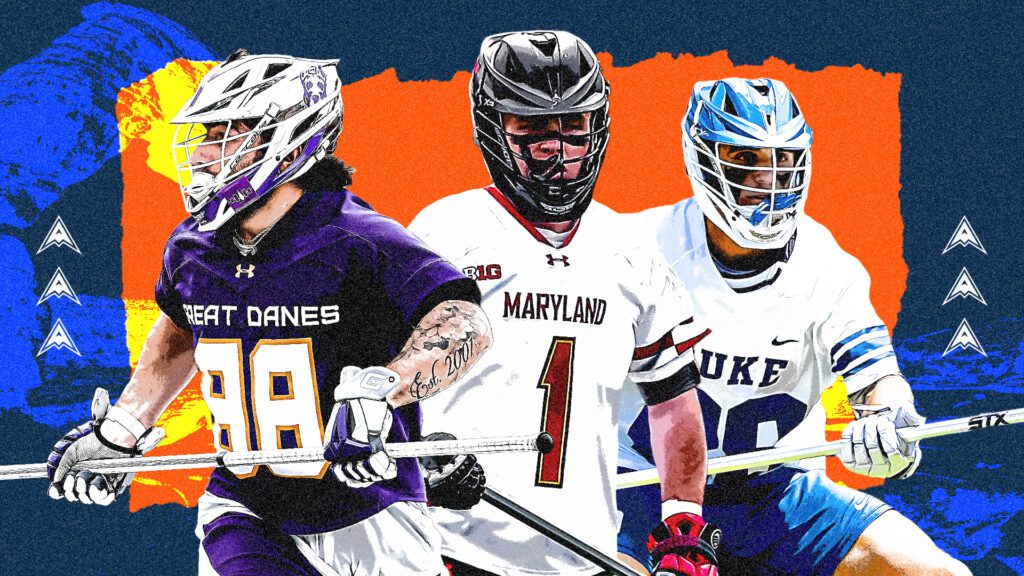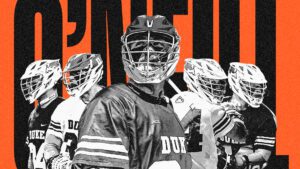
Five 2024 College Draft defensive prospects who could replace Matt McMahon
By Zach Carey | May 1, 2024
Following Matt McMahon’s retirement, the Utah Archers will have a new starting close defender in 2024. Fortunately for the club, McMahon is the only departure from last year’s typical 19-man roster. Ahead of Tuesday’s College Draft, that makes life a lot simpler for Archers Head Coach and General Manager Chris Bates.
Granted, the draft is not the only solution for filling the hole at close. Cam Wyers and Patrick Shoemay will both compete to start down low.
Wyers appeared in five games for the Archers in 2023. A close defender in college, he filled in at LSM after Jon Robbins suffered a season-ending injury. He fits the McMahon profile as a 6-foot-5 and 220 pound powerful lefty. He’s not the communicator that McMahon was — few are. But he’s played in defensive coordinator Tony Resch’s system and has the staff’s trust.
Shoemay was an underrated free agency pick-up for Utah. After spending time on the club’s 25-man roster in 2023 and impressing at the World Games for Team Canada, he enticed new suitors this offseason. Utah nabbing the big righty out of RIT on a two-year deal means he has a shot to start for the defending champs in 2024.
The club will still want another dart to throw at the third close spot, however. So these are five prospects who could be that player for Utah on Tuesday night.
Ajax Zappitello, Maryland
The best cover guy in this draft, Zappitello will enter the PLL as a day one starter. He’s a three-year full-timer for Maryland and has been the Terps’ best cover guy since taking a starting job. Even with 2023 no. 3 overall pick Brett Makar starting alongside him, Zappitello took the toughest matchups in the biggest games.
Zappitello projects to be an elite shutdown close defender. The Terp would provide a valuable counter to Utah's lefty close defenders. He has the potential to match elite-dodging lefties like Matt Rambo, Josh Byrne, and Kieran McArdle. He’s a complete defender who has nice size at 6-foot-1 and 190 pounds but can also hang with a variety of attackmen. He has the footwork and foot speed to keep up with threats like Michael Sowers along with the core strength to hold up against bruisers like Rambo. He plays picks well, and is rarely ever out of the play.
Ajax Zappitello got the best of Pat Kavanagh on this 1v1 rep 😤 @TerpsMLax
— TLN 🥍 (@LacrosseNetwork) March 3, 2024
(via ESPNU) pic.twitter.com/I8FIOuLhwy
Zappitello isn’t the king of caused turnovers. But he’s still averaged 1.57 per game in his three years as a starter. He’s not a flashy playmaker. Yet he’s capable in transition with four goals and five assists in his time in College Park.
The concern is he might not be around for Utah at eight overall. If he is, the Terp would be a no-brainer selection. He’s also the type of talent that could be worth trading up to get. Carolina’s pick at no. 4 overall could be the one to target. Utah has a stacked roster, so shipping off a late-round pick to Andy Towers and company would be a reasonable price.
Kenny Brower, Duke
As true close prospects go, Brower sits as the 1B to Zappitello’s 1A in the 2024 class. There’s no question he’ll enter the league and immediately be a lockdown defender. He has the same degree of big-game pedigree as Zappitello, but fits a different mold of defender.
Brower thrives in tight when he can use his 6-foot-2 and 215-pound frame to his advantage. His length is particularly apparent on film. At times he might lose a step to the elite change-of-direction attackmen. But he’s savvy enough to mitigate the damage.
Brower doesn’t jump off the page as a playmaker. He has zero points across his five-year Duke career and fewer caused turnovers than games played. That said, he doesn’t make mistakes, is rarely beaten, and has traits which will immediately apply to the pro game.
The Duke product is similar to Warren Jeffrey and Graeme Hossack. Perhaps too similar. In the past, the Archers have prioritized bigger, bulkier close defenders. Yet, with the diversity of offensive talent in this league, Zappitello would make the better fit as a counter to those lefty bruisers.
Jake Piseno, UAlbany
If Zappitello and Brower are the traditional best close prospects in this draft class, Albany’s Jake Piseno is the absolute wild card. Piseno has taken college lacrosse by storm this spring.
The 5-foot-8 and 180-pound pole is a menace of a player. He ranks second in the country in caused turnovers per game and fifth among defenders in ground balls per contest. Despite his size, he’s everywhere on the field. His stick is permanently in the passing lanes, and his bag of takeaway checks is the deepest in the game. Piseno also has 10 goals, four assists, and a 35.7% shooting percentage. He is the most skilled long pole in college lacrosse, and even takes runs as a part of Albany’s power play unit.
Piseno projects as more of an LSM in the PLL, so his fit as the McMahon replacement is uncertain. But he’s a great close defender too. He thrived playing close for Albany and for the Haudenosaunee at the World Games.
Although he might fit better at LSM, starting down low doesn’t mean he wouldn’t be able to play a part in transition. Plus the 32-second shot clock means it could be valuable to have him as a non-traditional offensive threat after faceoffs.
I like what Albany does here by letting Piseno flow from defense to offense off the faceoff win. pic.twitter.com/0RGuSJEl7G
— Adam Lamberti (@atlamberti) April 8, 2024
Utah was the worst transition offense in 2023, so Piseno could kill two birds with one stone. He’s far from a direct McMahon replacement. But he fits the bill as a righty defender who can match feet with the Michael Sowers and Chris Grays of the world. His size is a reasonable question mark. Still, it hasn't been an issue in college or on the international stage.
Scott Smith, Johns Hopkins
Scott Smith is a joy to watch because he is so fundamentally sound. He’s every JV defensive coordinator’s favorite defender. He owns passing lanes, plays body well, leads his opponent where he wants them to go, and is elite at getting to hands to disrupt a shot. He’s not the flashiest defender and likely doesn’t have elite measurables. But he makes up for it with technique, tenacity, and select but ruthless checks.
Smith has guarded many of the best offensive talents in this draft class. He’s not the lockdown option that Zappitello or Brower may be. But he doesn’t get lost, can guard a variety of offensive players, and provides value beyond how he handles his individual matchup.
Where the second tier of true close defenders lands will be worth watching. The depth at LSM including Piseno, Mason Woodward, and others complicates the picture. However once the Archers come up at 16th and the Whipsnakes do at 17th, there could be a run on defenders. Smith could be the guy to start it.
Brendan Lavelle, UPenn
Any defender who can neutralize Brennan O’Neill for 60 minutes is pro ready. In Penn’s March 1st upset of Duke, Lavelle held O’Neill to 0-for-6 shooting and two turnovers (both of which he caused). The Blue Devil’s only point of the day came after an off-ball switch got him open on the crease. Otherwise, Lavelle completely blanketed him.
Lavelle is so physical at the point of attack. Against O’Neill and in his other matchups, he wins by disrupting his opponents’ line to the cage. He’s incredible at fighting over picks by getting his hands on an attackman and moving them off the screen. Lavelle stands his ground and can take a shoulder to the chest. That allows him to go hunting for takeaway checks. He may be susceptible in space against the quickest attackmen in the league. But once he has his hands on a guy, he’s hard to beat.
Like Smith, he’s likely to be a later round option. He could fit well for the Archers at 24th or 32nd overall.
Other names to watch for Utah: Mason Woodward (Marquette), Marcus Hudgins (Ohio State), Jack DiBenedetto (Denver), Cole Kastner (Virginia)




